Social media analytics tools are software applications that collect, analyze, and interpret data from social media platforms, enabling businesses to track engagement metrics, audience demographics, and content performance. These tools provide actionable insights that inform strategic decision-making, enhance customer engagement, and optimize marketing strategies. Key features include data collection, sentiment analysis, and reporting capabilities, which help organizations understand user behavior and improve their social media campaigns. The article explores the importance of these tools, the challenges businesses may face, and best practices for effectively utilizing analytics to drive better decision-making and achieve marketing goals.

What are Social Media Analytics Tools?
Social media analytics tools are software applications designed to collect, analyze, and interpret data from social media platforms. These tools enable businesses and organizations to track engagement metrics, audience demographics, and content performance, facilitating informed decision-making. For instance, according to a report by Statista, 73% of marketers believe that their social media marketing efforts have been “somewhat effective” or “very effective” for their business, highlighting the importance of utilizing analytics tools to measure success and optimize strategies.
How do Social Media Analytics Tools function?
Social media analytics tools function by collecting, analyzing, and interpreting data from various social media platforms to provide insights into user behavior and engagement. These tools utilize algorithms to track metrics such as likes, shares, comments, and follower growth, allowing businesses to assess the effectiveness of their social media strategies. For example, tools like Hootsuite and Sprout Social aggregate data from multiple platforms, enabling users to visualize trends and measure performance against key performance indicators (KPIs). This data-driven approach supports informed decision-making by identifying successful content and areas needing improvement, ultimately enhancing marketing strategies and audience engagement.
What key features do these tools typically offer?
Social media analytics tools typically offer features such as data collection, sentiment analysis, engagement metrics, and reporting capabilities. Data collection allows users to gather information from various social media platforms, while sentiment analysis helps in understanding public perception by analyzing user comments and reactions. Engagement metrics provide insights into user interactions, such as likes, shares, and comments, which are crucial for measuring content effectiveness. Reporting capabilities enable users to visualize data trends and generate comprehensive reports for informed decision-making. These features collectively enhance the ability to analyze social media performance and guide strategic planning.
How do these features contribute to data collection?
Social media analytics tools enhance data collection by providing real-time insights into user behavior and engagement patterns. These features, such as sentiment analysis, demographic tracking, and trend identification, allow organizations to gather comprehensive data on audience preferences and interactions. For instance, sentiment analysis can quantify public opinion about a brand, while demographic tracking reveals the characteristics of the audience engaging with content. This data-driven approach enables businesses to make informed decisions, optimize marketing strategies, and improve customer engagement, ultimately leading to better decision-making outcomes.
Why are Social Media Analytics Tools important for businesses?
Social Media Analytics Tools are important for businesses because they provide actionable insights that drive strategic decision-making. These tools enable companies to track engagement metrics, audience demographics, and content performance, allowing for data-driven adjustments to marketing strategies. For instance, a study by HubSpot found that 70% of marketers reported that analytics tools significantly improved their ability to understand customer behavior and preferences. This data empowers businesses to optimize their social media campaigns, enhance customer engagement, and ultimately increase return on investment.
What insights can businesses gain from using these tools?
Businesses can gain valuable insights into customer behavior, preferences, and trends by using social media analytics tools. These tools enable companies to analyze engagement metrics, sentiment analysis, and demographic data, allowing them to tailor their marketing strategies effectively. For instance, a study by HubSpot found that 70% of marketers reported that social media analytics helped them understand their audience better, leading to improved customer targeting and increased conversion rates. By leveraging these insights, businesses can make data-driven decisions that enhance their overall performance and customer satisfaction.
How do these insights influence strategic decision-making?
Insights derived from social media analytics tools significantly influence strategic decision-making by providing data-driven evidence that informs business strategies. These insights allow organizations to understand customer preferences, market trends, and competitive dynamics, enabling them to tailor their offerings and marketing efforts effectively. For instance, a study by the Harvard Business Review found that companies leveraging social media analytics experienced a 20% increase in customer engagement and a 15% boost in sales, demonstrating the tangible impact of these insights on strategic outcomes. By integrating real-time data from social media, businesses can make informed decisions that align with consumer behavior and market demands, ultimately enhancing their competitive advantage.

How can businesses effectively utilize Social Media Analytics Tools?
Businesses can effectively utilize Social Media Analytics Tools by systematically analyzing engagement metrics, audience demographics, and content performance. By leveraging these insights, companies can tailor their marketing strategies to enhance customer engagement and optimize content delivery. For instance, a study by Hootsuite found that businesses using analytics tools saw a 30% increase in engagement rates when they adjusted their content based on audience insights. This data-driven approach allows businesses to make informed decisions, allocate resources efficiently, and ultimately improve their return on investment in social media marketing.
What steps should businesses take to implement these tools?
Businesses should first identify their specific goals for utilizing social media analytics tools, such as improving customer engagement or increasing sales. Next, they should select appropriate tools that align with these goals, considering factors like ease of use, integration capabilities, and cost. After selecting the tools, businesses must train their staff on how to effectively use them, ensuring that team members understand the features and functionalities. Following training, businesses should establish a regular schedule for analyzing data and generating reports to track progress and make informed decisions. Finally, businesses should continuously evaluate the effectiveness of the tools and adjust their strategies based on insights gained from the analytics.
How do businesses choose the right analytics tool for their needs?
Businesses choose the right analytics tool by assessing their specific needs, budget, and the features offered by various tools. They begin by identifying key performance indicators (KPIs) relevant to their goals, such as engagement rates or conversion metrics. Next, they evaluate tools based on functionality, ease of use, integration capabilities with existing systems, and customer support. For instance, a survey by Gartner indicates that 70% of organizations prioritize user-friendliness when selecting analytics tools. Additionally, businesses often consider scalability to ensure the tool can grow with their needs. By conducting thorough research and possibly trialing multiple options, companies can make informed decisions that align with their strategic objectives.
What are the best practices for integrating these tools into existing workflows?
The best practices for integrating social media analytics tools into existing workflows include aligning tool capabilities with organizational goals, ensuring user training, and establishing clear data governance policies. Aligning the tools with specific objectives, such as improving customer engagement or tracking brand sentiment, ensures that the analytics provide actionable insights. User training is essential, as it enables team members to effectively utilize the tools and interpret the data, leading to informed decision-making. Establishing data governance policies ensures that data is collected, stored, and analyzed in compliance with regulations, enhancing data integrity and security. These practices are supported by research indicating that organizations that align analytics with business objectives see a 20% increase in decision-making efficiency (Gartner, 2021).
What challenges might businesses face when using Social Media Analytics Tools?
Businesses face several challenges when using Social Media Analytics Tools, including data overload, integration issues, and interpretation difficulties. Data overload occurs when the volume of information generated is too vast, making it hard for businesses to identify actionable insights. Integration issues arise when these tools do not seamlessly connect with existing systems, leading to fragmented data and inefficiencies. Interpretation difficulties stem from the complexity of analyzing social media metrics, which can result in misinterpretation of trends and user sentiment. According to a report by Gartner, 70% of organizations struggle to derive meaningful insights from their data, highlighting the prevalence of these challenges in the industry.
How can data privacy concerns impact the use of these tools?
Data privacy concerns can significantly impact the use of social media analytics tools by limiting data collection and analysis capabilities. When users are apprehensive about how their personal information is handled, they may restrict access to their data or opt out of sharing, which reduces the effectiveness of these tools. For instance, regulations like the General Data Protection Regulation (GDPR) in Europe impose strict guidelines on data usage, compelling organizations to ensure compliance or face substantial fines. This legal framework can hinder the ability of companies to gather comprehensive insights, ultimately affecting decision-making processes based on incomplete data.
What common pitfalls should businesses avoid when analyzing social media data?
Businesses should avoid the pitfall of relying solely on vanity metrics when analyzing social media data. Vanity metrics, such as likes and shares, do not provide meaningful insights into customer behavior or business performance. Instead, businesses should focus on actionable metrics like engagement rates, conversion rates, and customer sentiment, which directly correlate with business objectives. Research by HubSpot indicates that companies prioritizing actionable metrics see a 20% increase in marketing effectiveness, demonstrating the importance of focusing on data that drives real results.

What are the specific benefits of using Social Media Analytics Tools for decision-making?
Social Media Analytics Tools provide critical insights that enhance decision-making by analyzing user engagement, sentiment, and trends. These tools enable organizations to track performance metrics, such as likes, shares, and comments, which inform marketing strategies and content creation. For instance, a study by HubSpot found that 70% of marketers reported that social media analytics significantly improved their ability to make data-driven decisions. Additionally, these tools help identify target audiences and optimize campaigns, leading to increased ROI. By leveraging real-time data, businesses can adapt quickly to market changes, ensuring they remain competitive and relevant.
How do these tools enhance customer engagement?
Social media analytics tools enhance customer engagement by providing insights into customer behavior and preferences. These tools analyze data from social media interactions, allowing businesses to tailor their content and communication strategies to meet customer needs effectively. For instance, a study by Sprout Social found that 70% of consumers feel more connected to brands that engage with them on social media, demonstrating the direct impact of analytics on fostering relationships. By leveraging these insights, companies can create targeted campaigns, respond promptly to customer inquiries, and ultimately increase customer loyalty and satisfaction.
What metrics should businesses focus on to measure engagement effectively?
Businesses should focus on metrics such as engagement rate, click-through rate (CTR), conversion rate, and audience growth rate to measure engagement effectively. The engagement rate, calculated by dividing the total interactions (likes, comments, shares) by total followers, provides insight into how well content resonates with the audience. The click-through rate indicates the percentage of users who click on a post or ad, reflecting the effectiveness of calls to action. The conversion rate measures the percentage of users who take a desired action, such as making a purchase, after engaging with content, showcasing the impact of engagement on business goals. Lastly, the audience growth rate tracks the increase in followers over time, indicating the effectiveness of engagement strategies in attracting new users. These metrics collectively offer a comprehensive view of engagement and its influence on business performance.
How can engagement metrics inform content strategy?
Engagement metrics can inform content strategy by providing insights into audience preferences and behaviors. By analyzing metrics such as likes, shares, comments, and click-through rates, content creators can identify which types of content resonate most with their audience. For instance, a study by HubSpot found that content with higher engagement rates leads to increased brand loyalty and customer retention. This data allows marketers to tailor their content to align with audience interests, ultimately enhancing the effectiveness of their content strategy.
In what ways do Social Media Analytics Tools support marketing strategies?
Social Media Analytics Tools support marketing strategies by providing insights into audience behavior, engagement metrics, and content performance. These tools analyze data from various social media platforms, allowing marketers to identify trends, measure campaign effectiveness, and optimize content for better reach. For instance, a study by HubSpot found that 70% of marketers reported that social media analytics improved their understanding of customer preferences, leading to more targeted marketing efforts. Additionally, tools like Google Analytics and Hootsuite enable real-time tracking of key performance indicators, facilitating data-driven decision-making that enhances overall marketing effectiveness.
How can businesses track the effectiveness of their campaigns?
Businesses can track the effectiveness of their campaigns by utilizing social media analytics tools that provide metrics on engagement, reach, and conversion rates. These tools, such as Google Analytics, Hootsuite, and Sprout Social, allow businesses to analyze data related to user interactions, demographics, and behavior patterns. For instance, a study by HubSpot found that companies using analytics tools saw a 20% increase in ROI from their marketing campaigns due to better-targeted strategies. By measuring key performance indicators (KPIs) like click-through rates and customer acquisition costs, businesses can make informed decisions to optimize their marketing efforts.
What role does audience segmentation play in optimizing marketing efforts?
Audience segmentation plays a crucial role in optimizing marketing efforts by allowing businesses to tailor their strategies to specific groups of consumers. This targeted approach enhances engagement and conversion rates, as marketing messages resonate more effectively with distinct audience characteristics. For instance, a study by HubSpot found that segmented email campaigns can lead to a 760% increase in revenue. By analyzing demographic, behavioral, and psychographic data, marketers can create personalized content that meets the unique needs and preferences of each segment, ultimately driving better results and maximizing return on investment.
What are some practical tips for maximizing the use of Social Media Analytics Tools?
To maximize the use of Social Media Analytics Tools, focus on setting clear objectives for your analysis. Establish specific goals, such as increasing engagement or improving brand awareness, to guide your data collection and interpretation. Utilize the built-in features of analytics tools, such as audience insights and engagement metrics, to tailor your content strategy effectively. Regularly monitor key performance indicators (KPIs) like reach, impressions, and conversion rates to assess the impact of your social media efforts. Additionally, segment your audience data to understand different demographics and tailor your messaging accordingly. By consistently analyzing and adjusting your strategies based on data insights, you can enhance your decision-making process and achieve better results.



